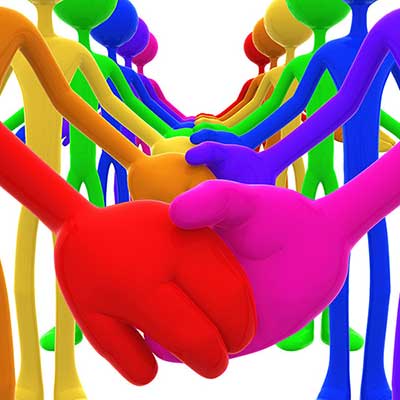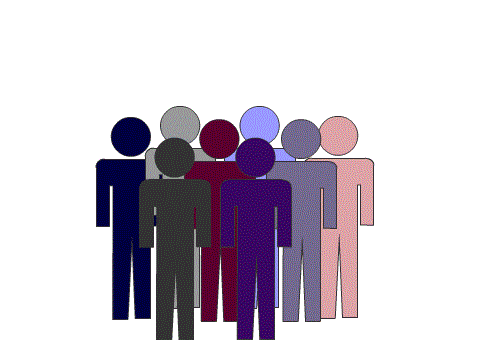Possible problems with teams and how to overcome them
As we have already spoken about - teams are not always necessary within an organisation, and sometimes the task just does not require it. We have also looked at the fact that teams go through stages of development and this can be very unproductive too. Here are some other reasons why teams are not always the solution to all organisational problems.
Teams and 'quality' decision making
Miner (1984) argues that teams make average but not better decisions than individuals, and further research has indicated that the quality of work group decisions is consistently below that made by the most capable individual members (Rogelberg et al, 1992); whilst Michaelson et al (1989) argue that team results are often more accurate, but take far longer for decisions to be reached (Vroom & Yetton, 1973).
Audio: Decision making in teams
(22 seconds)
Download a transcript of this audio/recording

3D Full Spectrum Unity Holding Hands Concept by Scott Maxwell from Flickr, CC BY-SA 2.0
The Ringelman effect
According to Ringelman (1913), individual effort tends to decrease as the group size increases. This has become known as the Ringelman Effect or Social Loafing.
Research has revealed that social loafing is most likely to occur when:
- the task is perceived as boring, unimportant, or simple;
- team members perceive that their individual effort will not be identifiable;
- the nature of each person's contribution was similar to others;
- team members actually expected their colleagues to loaf.
Audio: Ringelman effect
(47 seconds)
Download a transcript of this audio/recording

Working Together Teamwork Puzzle Concept by Scott Maxwell from Flickr, CC BY-SA 2.0
Social loafing
In order to avoid social loafing, Greenberg and Baron (1997) suggest:
- making the work more involving;
- if people are interested then they are more likely to remain engaged;
- identifying individual workers;
- if individual work can be identified, it stops people from being able to hide in generic task results;
- rewarding contributions to the team;
- rewarding an individual's ability to help other team members meet their goal, not just their own contribution;
- threatened punishment;
- that fear of being punished generally results in improved performance.
Group norms
When individuals are assigned to work together, for whatever task, they establish expected modes of behaviour and beliefs both formally and informally. These are known as Group Norms, and they tend to guide individual members to behave in a particular way, as they want to 'fit-in' and feel as if they belong. There have been a variety of interpretations for how and why these norms develop.
Individual members can yield to group pressure to conform to group norms, in three main ways (Asch, 1956):
(hover over the headings for more info)
Audio: Group norms
(1 minute 18 seconds)
Download a transcript of this audio/recording
The reality is that teams can establish very clear and controlling ways of behaving, and these can be detrimental to effective decision-making.
Risky shift phenomenon
Working in teams can create what Stoner (1968) refers to as Risky Shift Phenomenon. This can be categorised as:
(hover over the headings for more info)
Audio: Risky shift phenomenon
(33 seconds)
Download a transcript of this audio/recording
Risky shift phenomenon can mean that the best decisions are not always taken, and this can have difficult consequences.
Groupthink
Another way in which group norms can have a detrimental effect on decision-making is identified as Groupthink (Janis, 1972):
Groupwork
Person A: Illusion of invulnerability: "Together we are invincible!"
Person B: Assumptions of morality: "We act as a moral compass together - we would not do any wrong..."
Person C: Collective rationalisations: "Anything that does not conform to our viewpoint will be dismissed as inaccurate"
Person D: Stereotyping: "Other teams are just saying we are wrong because they are jealous of how well we work"
Person E: Self-censorship: "I am not happy with the team's decision, but I will go along with it because I might be laughed at otherwise"
Person F: Illusions of unanimity: "All those in favour, say aye...and those against..stay quiet"
Person G: Mind-guards: "Just ignore those people who think we are wrong - how can all of us be wrong????"
Person H: Direct pressure: "Shut up...or shift out...."
×





